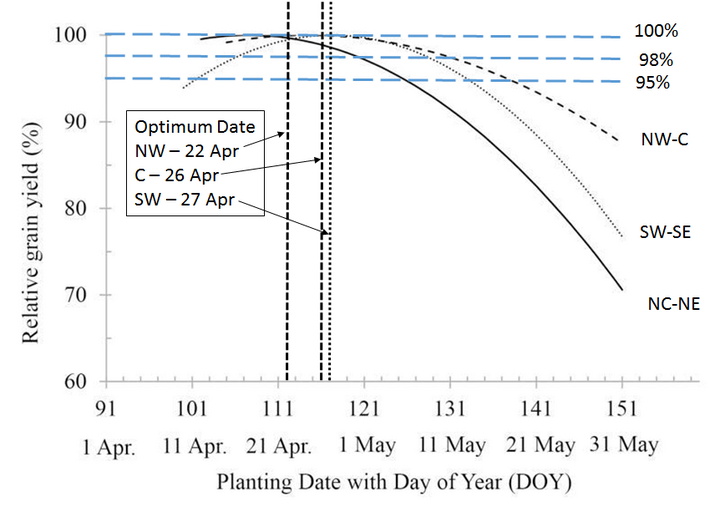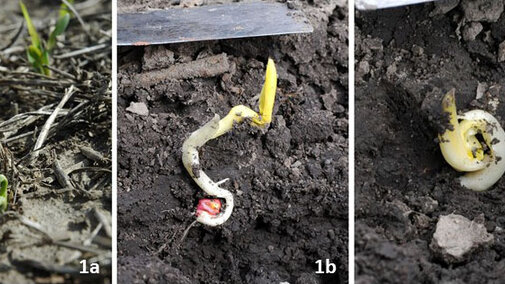Mid-April approaches and days slowly grow longer. But, irrespective of the calendar, soil temperatures at 4 inches hovered around 40⁰F early this week and seven-day lows stayed near freezing. Our hopes for an early start to the corn planting season may be futile. Nevertheless, warmer temperatures in the forecast will quickly alleviate our concerns and provide encouragement for a good start to the planting season. We’ll address here our thinking on planting corn in cold soils as well as the question in our title: Is planting early always best?
What if it Does Stay Cool and Damp?
What do we need to keep in mind as we consider planting corn? This question was summarized last year in CropWatch. Let’s review some of the points we made then.
Before planting, check the weather forecast and soil temperatures for your area. It’s wise to check the soil temperature of each field early in the morning you intend to plant. Wet soils or fields with more crop residue tend to have lower soil temperatures relative to drier soils or fields with less crop residue. Check the seed tag or check with your seed dealer regarding the cold tolerance of your corn hybrids. Be aware that hybrids vary in cold tolerance and company rating scales differ. Cold tests can help ascertain seed viability. Let’s review ideas on cold stress.
Cold Stress in Corn — Imbibitional Chilling
Certainly plant hybrids that are more cold tolerant first. Be aware though that “imbibitional chilling” is a physical phenomenon that can override genetics. Imbibitional water uptake occurs within the first 48 hours after a seed is planted. Once planted, corn seeds need a two-day (48-hour) window when the soil temperature at planting depth does not drop much below 50°F. When soil temperatures drop much lower than 50°F within that two-day time frame, chilling injury may affect seed germination and subsequent seedling growth (Figure 1). During the osmotic phase of water uptake, which starts about 48 hours after the initial imbibitional phase of water uptake ends, the risk of chilling injury approaches zero. Thereafter, temperatures below 50°F can slow germination and delay seedling emergence. This can result in a longer exposure to soil-borne pathogens, particularly in soggy wet soils. If you expect the latter, use fungicide seed treatment for at least your earliest planted corn fields.
When corn seeds imbibe (take up) water, cell membranes stretch and cells expand. When a damaged cell membrane rehydrates, it may not return to its normal shape and size. This can create a "leaky" cell. Water is at its densest at about 39°F so when cold water is imbibed, it may result in additional membrane damage. These ruptured membranes may occur in the cell walls and in the mitochondria. In the plant this action may disrupt the embryo/endosperm enzymatic conversion to energy, but mostly results in leakage of cell solutes and sugars. This, in turn, is likely to reduce growth rate and interfere with growth of the emerging seedling.
- Debate exists about what specific temperature and timing causes imbibitional chilling. However, corn seeds that imbibe cold water (in the low 40s) in the first 48 hours after planting undoubtedly are affected.
- Planting when soil temperatures are above 50°F — and are not anticipated to drop much below this the following 48 hours — alleviates concerns of imbibitional chilling affecting corn emergence. Some scientists suggest that corn will not be injured at soil temperatures as low as 41°F; however, there is certainly some risk of injury from imbibitional chilling at those low temperatures.
Corn Planting Windows: Is Early Planting Always Best?
We’ve learned a lot about corn planting dates in the last 5 to 10 decades. Early on planting dates were restricted by the necessity for tillage for weed control and to improve seed-soil contact. In addition, later planting helped avoid specific, destructive corn insects — e.g., corn rootworms — and probably helped us avoid pathogens associated with cold, wet soils. Larger farms, innovations in planting equipment, more cold-tolerant hybrids, and improved herbicides, fungicides, and insecticides, have allowed us to plant seemingly earlier and earlier every year. In addition, climate variability manifests itself in unprecedented swings in temperature and precipitation forcing us to change our assumptions. One of these assumptions is that planting early is always best.

A new summary of planting date data from Iowa suggests that rather than thinking of a specific date as optimum for planting — with certain declining yields certain to follow — we need to consider buffer periods around optimum planting dates as a window of time within which corn yields are optimized. This concept allows us to think in terms of a time frame within which yield is optimized and can help account for year-to-year variation, present weather conditions, and weather forecasts.
We realize that Nebraska is not Iowa, but we can consider Iowa’s northwest, central and southwest districts as “near-equivalent” districts to much of eastern Nebraska. (See Figure 2, adapted from the Iowa article.) Optimum planting date windows to obtain at least 98% yield potential range from April 15-May 9 for northwest and cental Iowa; from April 17 to May 8 for southwest Iowa; and from April 12-30 for north central and northeast Iowa. To achieve at least 95% yield potential, those ranges extend from April 15 to May 18 for northwest and central Iowa; from April 12 to May 13 for southwest and southeast Iowa; and from April 12 to May 5 for north central and northeast Iowa.
A corn producer interested in fine-tuning corn planting-date management, should wait for conditions allowing 48-hour windows of soil temperatures 50°F and above. After all, in the final analysis, fine-tuning planting date management is not about the date you plant your FIRST field, rather it is about when you can plant your LAST field! If you wait until soil temperatures are projected to be above 50°F for the rest of the planting season (and of course to not “mud in” the seed), you will likely be planting your first field later than the beginning of the optimum period and thus need more rain-free periods afterward to get the rest of your fields planted. Take advantage of 48-hour windows of 50°F soil temperatures with good planting conditions so your farmwide corn field planting dates fall more in the optimum periods as shown in the Iowa article.
CropWatch posts daily and weekly soil temperature averages (provided by the Nebraska State Climate Office) in map and table formats for sites across the state. Be sure to check in-field soil temperatures just after dawn — even if using a cheap meat thermometer. Schedule planting based on those and the 48-hour forecast.
Take This to the Field
Concerning cool soils and corn planting dates, for best results, begin planting a more cold-tolerant corn hybrid when soil temperatures are in the high 40s and the short-term forecast calls for warm days that will continue pushing soil temperatures higher. If soil temperatures are in the high 40s and the weather forecast calls for cold wet conditions within the next 48 hours, soil temperatures will likely drop and planting should be delayed until temperatures warm.
Sometimes, a given year’s optimum planting date may actually be in May! Planting early is not always the best!
For more information on Soybean Planting Considerations, please see this 2017 CropWatch article.
Reference
Abendroth, Lori, J, Krishna P. Woli, Anthony J.W. Myers, and Roger W. Elmore. Yield-Based Corn Planting Date Recommendation Windows for Iowa. Crop Forage Turfgrass Manage. Volume 3. doi:10.2134/cftm2017.02.0015. (Download article)

